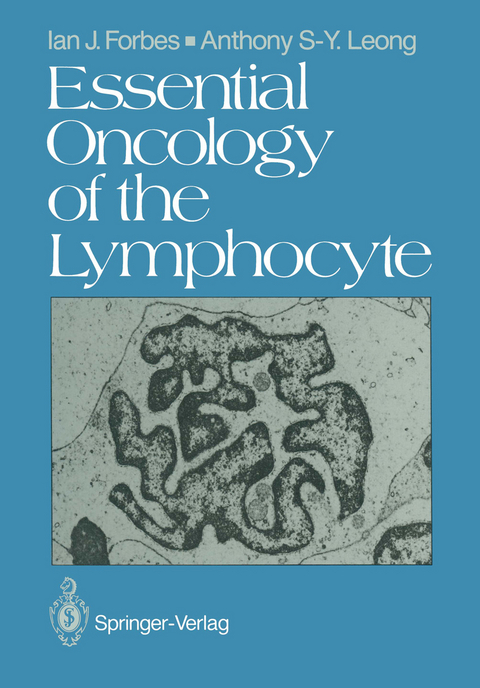
Essential Oncology of the Lymphocyte
Springer London Ltd (Verlag)
978-1-4471-1469-7 (ISBN)
1 Cancer Biology.- Development of Cancers from Single Cells.- Diversity of Tumour Cells.- Differentiation of Malignant Cells.- 2 Derangement of the Genome as a Cause of Cancer.- The Chromosomes.- Chromosomal Abnormalities in Cancer.- Susceptibility to Chromosome Damage and Cancer.- Constitutional Cytogenetic Abnormalities.- Fragile Sites.- 3 Derangements of the Mechanisms Controlling Growth.- Cell Cycle.- Signal Transduction.- Immortalisation and Transformation.- Mechanisms Leading to Autonomous Growth.- Differentiation Arrest.- 4 Multiple Steps in the Genesis of a Cancer.- Initiation.- Promotion.- Progression.- Conclusions.- 5 Multifactorial Aetiology of Cancers.- Population and Familial Factors.- Carcinogens.- Radiation.- Viruses.- Viruses in the Causation of Animal Cancers.- Viruses in the Causation of Human Cancers.- Immunodepression and Immunosuppression.- Prolonged Antigenic Stimulation.- 6 Oncogenes.- Translation Products of Oncogenes.- Oncogene Products with Protein Kinase Activity.- GTP-binding Oncogene Products.- Oncogenes Whose Products Bind to DNA.- Oncogene Product with Growth Factor Activity.- Oncogenes Encoding Receptors for Growth Factors.- Oncogenes Whose Products have Undefined Function.- Some Important Non-human Oncogenes.- Aberrations of Oncogenes in Cancer.- Proteins Homologous to Oncogene Products.- Transgenic Mice.- Oncogenes in Human Tumours.- Multiple Oncogene Expression.- Conclusions.- 7 Growth Factors.- Mechanisms of Action of Growth Factors.- Growth Factors in Malignant Transformation.- Growth Factors for Haematopoietic Cells.- Chalones and Other Antiproliferative Factors.- Conclusions.- 8 The Lymphoid Tissues.- Origin of Lymphocytes.- T Lymphocytes.- B Lymphocytes.- NK, ADCC and Lymphokine-activated Killer Cells.- Accessory Cells.- Activation of Macrophages.- Lymphoid Organs and Immunological Function.- Lymphocyte Circulation.- Organisation of Immunological Function.- 9 The Major Histocompatibility Complex.- Tissue Distribution of MHC Products.- MHC Gene Products and Their Specificities.- Immunoregulatory Function of the MHC.- Mixed Lymphocyte Reaction.- Graft Versus Host Reaction.- Association of Diseases with MHC Phenotype.- Conclusions.- 10 T Cell Differentiation.- The Thymus.- T Lymphocytes in Bone Marrow.- T Cells in Lymph Nodes.- T Cell Subsets.- T Cell Receptor.- Genetic Mechanisms in T Cell Differentiation.- T Cell Activation.- Signal Transduction in T Cell Activation.- 11 B Cell Differentiation.- Antigen-independent B Cell Differentiation.- B Lymphocyte Differentiation in Postnatal Life.- Antigen-dependent B Cell Differentiation.- B Cell Subsets.- Immunoglobulin.- Genetic Mechanisms in B Cell Differentiation.- 12 B Cell Activation.- T Cells in B Cell Activation.- Accessory Cells in B Cell Activation.- B Cell Activation by Cross-linking Immunoglobulin.- Soluble Factors in B Cell Activation.- Cellular Events in B Lymphocyte Activation.- Conclusions.- 13 Immunoregulatory Mechanisms.- Systems Controlling Immunological Function.- Suppressor Mechanisms.- Idiotypes.- Immunological Tolerance.- Regulatory Mechanisms in B Cell Malignancies.- 14 Technology of Investigation and Diagnosis.- Hybridoma Technology and Monoclonal Antibodies.- Gene Cloning.- Gene Probing.- Immunodiagnostic Methods.- Immunological Methods.- Immunohistochemical Methods.- Histochemical Stains.- Flow Cytometry.- Ultrastructural Analysis.- Conclusions.- 15 B Cell Neoplasia.- Immunological Abnormalities in Lymphoid Malignancies.- Chromosomal Abnormalities in B Cell Malignancies.- Oncogene Activation in B Cell Neoplasia.- Immunoglobulin Gene Rearrangements.- 16 B Cell Leukaemias.- Acute Lymphoblastic Leukaemia.- B-Chronic Lymphocytic Leukaemia.- B Cell Prolymphocytic Leukaemia.- Hairy Cell Leukaemia.- Chronic Cold Agglutinin Disease.- Lymphoplasmacytoid Lymphoma.- Plasma Cell Dyscrasias.- 17 B Cell Lymphomas.- B Cell Lymphomas of the Deep Cortex.- B Cell Lymphomas of the Superficial Cortex.- B Cell Lymphomas of the Medulla: Plasmacytoma.- Undifferentiated B Cell Lymphomas.- Extranodal B Cell Lymphomas.- Hodgkin’s Disease.- 18 T Cell Neoplasia.- Chromosomal Abnormalities in T Cell Malignancies.- Gene Rearrangements in T Cell Malignancies.- 19 T Cell Leukaemias and Lymphomas.- T Cell Neoplasms of the Bone Marrow Compartment.- T Cell Neoplasms of the Thymic Compartment.- T Cell Neoplasms of the Peripheral Compartment.- 20 Treatment, Treatment Failure and Future Possibilities.- Treatment Failure Exemplified by Lymphocytic Leukaemia.- Immunotherapy.- Cytokines and Other Biological Agents.- New Drugs and Other Treatments.- Conclusions.
| Zusatzinfo | XXII, 376 p. |
|---|---|
| Verlagsort | England |
| Sprache | englisch |
| Maße | 170 x 244 mm |
| Themenwelt | Sachbuch/Ratgeber ► Gesundheit / Leben / Psychologie ► Lebenshilfe / Lebensführung |
| Medizin / Pharmazie ► Medizinische Fachgebiete ► Dermatologie | |
| Medizinische Fachgebiete ► Innere Medizin ► Hämatologie | |
| Medizin / Pharmazie ► Medizinische Fachgebiete ► Onkologie | |
| Studium ► 2. Studienabschnitt (Klinik) ► Pathologie | |
| Studium ► Querschnittsbereiche ► Infektiologie / Immunologie | |
| ISBN-10 | 1-4471-1469-8 / 1447114698 |
| ISBN-13 | 978-1-4471-1469-7 / 9781447114697 |
| Zustand | Neuware |
| Haben Sie eine Frage zum Produkt? |
aus dem Bereich


